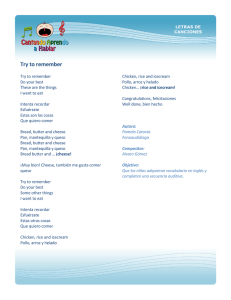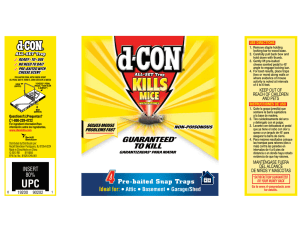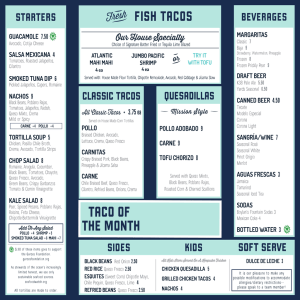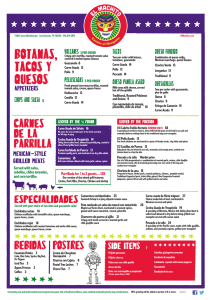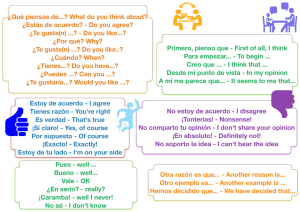Un trozo de queso - Houghton Mifflin Harcourt
Anuncio
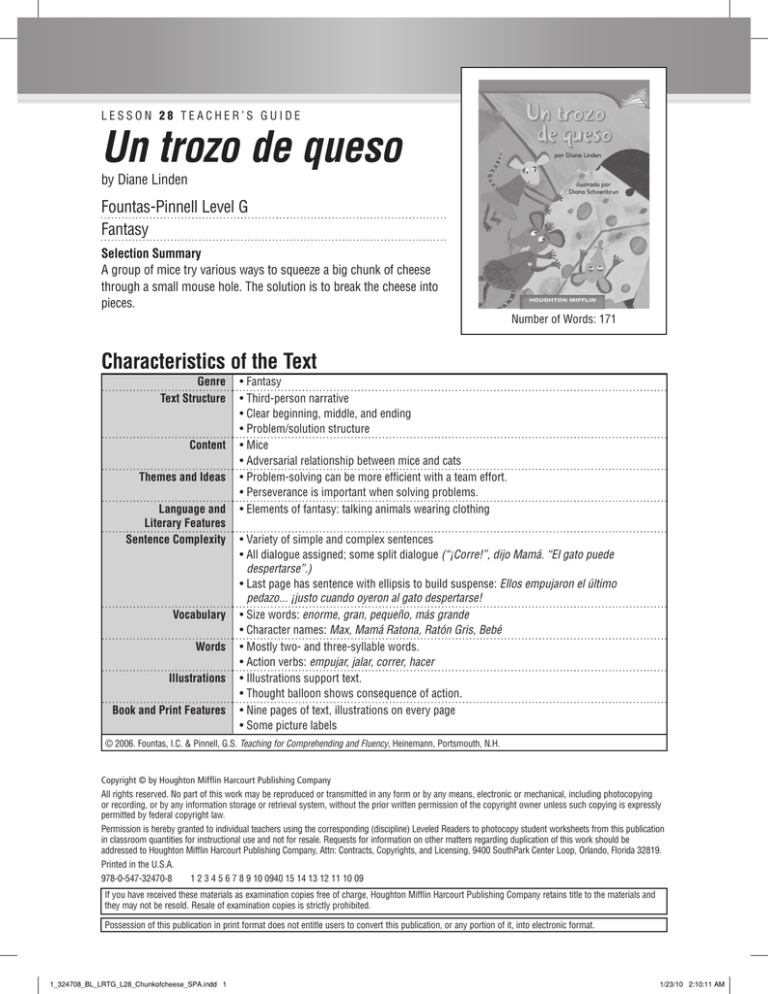
Nivel: F Un tr z de ques EDL: 6–12 Género: Fantasía Estrategia: Inferir/Predecir LESSON 28 TEACHER’S GUIDE Un trozo de queso Destreza: Estructura del cuento Número de palabras: 173 por Diane Linden 1.6.3 by Diane Linden ilustrado por Diana Schoenbrun Fountas-Pinnell Level G Fantasy HOUGHTON MIFFLIN Libritos nivelados en línea Selection Summary A group of mice try various ways to squeeze a big chunk of cheese through a small mouse hole. The solution is to break the cheese into pieces. ISBN-13:978-0-547-03811-7 ISBN-10:0-547-03811-9 1034034 1_038117_LR6_3CV_CHEES.indd 1 H O U G H T O N MI F F L I N Number of Words: 171 4/4/08 4:05:30 PM Characteristics of the Text Genre Text Structure Content Themes and Ideas Language and Literary Features Sentence Complexity Vocabulary Words Illustrations Book and Print Features • Fantasy • Third-person narrative • Clear beginning, middle, and ending • Problem/solution structure • Mice • Adversarial relationship between mice and cats • Problem-solving can be more efficient with a team effort. • Perseverance is important when solving problems. • Elements of fantasy: talking animals wearing clothing • Variety of simple and complex sentences • All dialogue assigned; some split dialogue (“¡Corre!”, dijo Mamá. “El gato puede despertarse”.) • Last page has sentence with ellipsis to build suspense: Ellos empujaron el último pedazo... ¡justo cuando oyeron al gato despertarse! • Size words: enorme, gran, pequeño, más grande • Character names: Max, Mamá Ratona, Ratón Gris, Bebé • Mostly two- and three-syllable words. • Action verbs: empujar, jalar, correr, hacer • Illustrations support text. • Thought balloon shows consequence of action. • Nine pages of text, illustrations on every page • Some picture labels © 2006. Fountas, I.C. & Pinnell, G.S. Teaching for Comprehending and Fluency, Heinemann, Portsmouth, N.H. Copyright © by Houghton Mifflin Harcourt Publishing Company All rights reserved. No part of this work may be reproduced or transmitted in any form or by any means, electronic or mechanical, including photocopying or recording, or by any information storage or retrieval system, without the prior written permission of the copyright owner unless such copying is expressly permitted by federal copyright law. Permission is hereby granted to individual teachers using the corresponding (discipline) Leveled Readers to photocopy student worksheets from this publication in classroom quantities for instructional use and not for resale. Requests for information on other matters regarding duplication of this work should be addressed to Houghton Mifflin Harcourt Publishing Company, Attn: Contracts, Copyrights, and Licensing, 9400 SouthPark Center Loop, Orlando, Florida 32819. Printed in the U.S.A. 978-0-547-32470-8 1 2 3 4 5 6 7 8 9 10 0940 15 14 13 12 11 10 09 If you have received these materials as examination copies free of charge, Houghton Mifflin Harcourt Publishing Company retains title to the materials and they may not be resold. Resale of examination copies is strictly prohibited. Possession of this publication in print format does not entitle users to convert this publication, or any portion of it, into electronic format. 1_324708_BL_LRTG_L28_Chunkofcheese_SPA.indd 1 1/23/10 2:10:11 AM Un trozo de queso by Diane Linden Build Background Read the title to children and have them look at the cover illustration. Talk with children about what the mice are doing with the cheese. Build interest by asking a question such as the following: ¿Cómo creen que los ratones pasarán el queso a través del hueco? Tell children that this story is fantasy, or a story that could not happen in real life. Introduce the Text Guide children through the text, noting important ideas, and helping with unfamiliar language and vocabulary. Here are some suggestions: Page 2: Explain that this story is about mice that have a problem with cheese. Suggested language: Vayan a la página 2. Aquí están Max y Mamá Ratona. La primera oración dice: Max vio un enorme trozo de queso.Trozo significa casi lo mismo que pedazo. Si el trozo de queso es enorme, ¿creen que pasará a través del pequeño hueco que se ve en el dibujo? Page 3: Remind children that they can use information in the pictures to help them read. ¿Por qué creen que los ratones quieren empujar rápido el queso a través del hueco? ¿Qué podría suceder si el gato se despierta? Page 4: Draw attention to the picture. El trozo de queso es grande. Digan la palabra grande. ¿Qué letra esperan ver al comienzo de la palabra grande? Encuentren la palabra grande y pongan el dedo debajo de ella. Los ratones tienen un problema. ¿Cómo podrían resolver su problema? Page 5: ¿Cómo están intentando resolver estos tres ratones su problema? ¿Creen que esto funcionará? ¿Por qué sí? ¿Por qué no? Ahora, vuelvan al comienzo para descubrir cómo los ratones resuelven su problema. Words to Know bola cabeza correr deber grande gritar oír segundo Grade 1 2 Lesson 28: Un trozo de queso © Houghton Mifflin Harcourt Publishing Company 1_324708_BL_LRTG_L28_Chunkofcheese_SPA.indd 2 1/23/10 2:10:12 AM Read As children read, observe them carefully. Guide them as needed, using language that supports their problem solving ability. Respond to the Text Personal Response Ask children to share their personal responses to the story. Begin by asking what they liked best about the story, or what they found interesting. Suggested language: ¿Cómo creen que se sienten los ratones después de hacer pasar el queso a través del hueco? ¿Por qué? Ways of Thinking As you discuss the text, make sure children understand these teaching points: Thinking Within the Text Thinking Beyond the Text Thinking About the Text • Max finds a big chunk of cheese. • Everyone can work together to solve a problem. • The author teaches a lesson about solving problems—don’t give up. • The mice try different ways to get the cheese through the mouse hole, but it will not fit. • It can take several tries to solve a problem. • Max has an idea that works— moving the cheese through the hole piece by piece. • A thought balloon shows why Mamá doesn’t want to make the mouse hole bigger. © 2006. Fountas, I.C. & Pinnell, G.S. Teaching for Comprehending and Fluency, Heinemann, Portsmouth, N.H. Choices for Support Fluency Have small groups choose a scene to present as Readers’ Theater. Remind them to use their voices to show how the characters feel. Phonemic Awareness and Word Work Provide practice as needed with words and sounds, using one of the following activities: • Ending Sounds Say each of the following words one at a time: ratón, queso, enorme, el, empujar, garras. Have children repeat each word, and then say the ending sound. • Rhyming Words Say the word cat and have children repeat it. Ask them to name rhyming words for gato (pato, rato) Follow the same procedure with these words: queso (eso, peso), casa (pasa, masa), poco (toco, foco, loco). • Finding the Sound Display some children’s names with /p/ in the first or last name, pointing out any /p/ sounds as you say each name. Afterward, have children point to some /p/ sounds in the displayed names. Ask them to open their books to pages 8 and 9. Have them follow along as you slowly read the sentences on each page and stop you by raising their hands when you get to a word that has a /p/ sound in it somewhere (poco, pedazo, pasó, por, podemos, pasar). Follow a similar procedure for the sound /k/ (comieron, poco, queso, hueco), using different displayed names and the same book pages. Grade 1 3 Lesson 28: Un trozo de queso © Houghton Mifflin Harcourt Publishing Company 1_324708_BL_LRTG_L28_Chunkofcheese_SPA.indd 3 1/23/10 2:10:12 AM Writing About Reading Critical Thinking Read the directions for children on Hoja reproducible 28.6 and guide them in answering the questions. Responding Read aloud the questions at the back of the book and help children complete the activities. Target Comprehension Skill Story Structure Tell children that a story has different parts—who the story is about, where the story takes place, and what happens in the story. Model how to think about story structure. Think Aloud ¿Sobre quién trata el cuento? Trata sobre Max, Mamá Ratona, Ratón Gris, Bebé Ratón y el gato. ¿Dónde tiene lugar el cuento? Tiene lugar cerca de un hueco de ratón. ¿Qué sucede? Los ratones prueban diferentes formas de pasar un trozo de queso a través del hueco. Al final rompen el queso en pedazos para hacerlo pasar a través del hueco. Practice the Skill Guide children in identifying the characters, setting, and events in another story they have read. Writing Prompt Read aloud the following prompt. Have children write their response, using the writing prompt on page 6. What part did team work play in solving the problem of the chunk of cheese? Use details from the story to support what you say. Grade 1 4 Lesson 28: Un trozo de queso © Houghton Mifflin Harcourt Publishing Company 1_324708_BL_LRTG_L28_Chunkofcheese_SPA.indd 4 1/23/10 2:10:13 AM Responder Estructura del cuento ¿De quién trata el cuento? ¿Dónde ocurre el cuento? ¿Qué ocurre? Haz un diagrama. DESTREZA CLAVE ¡A platicar! El texto y tú Piensa en una ocasión en que necesitaste ayuda con un problema. ¿Cuál era el problema? ¿Quién te ayudó? ¿Qué hiciste? Lección 28 Nombre HOJA REPRODUCIBLE 28.6 Fecha Piénsalo 11 Un trozo de queso Piénsalo Escucha la pregunta. Escribe una respuesta. Las respuestas pueden variar. 1_038117_LR6_3BL_QUESO_L28.indd 11 12/5/09 12:58:32 AM 1. ¿Qué hizo Max para resolver el problema? Max y los otros ratones partieron el queso en trozos pequeños para que pudieran pasar por el hueco. Hacer conexiones Piensa en algún problema que resolviste. Escribe varias oraciones acerca de lo que hiciste. Lea las instrucciones a los niños. Piénsalo © Houghton Mifflin Harcourt Publishing Company. All rights reserved. 1_352879RTXSAN_U6_LR_TAI.indd 8 Grade 1 5 8 Grado 1, Unidad 6: ¡Tres hurras por nosotros! 8/12/09 3:37:33 AM Lesson 28: Un trozo de queso © Houghton Mifflin Harcourt Publishing Company 1_324708_BL_LRTG_L28_Chunkofcheese_SPA.indd 5 1/23/10 2:10:14 AM Nombre Fecha Un trozo de queso ¿Cómo ayudó el trabajo en equipo a solucionar el problema del trozo de queso? Da detalles del cuento para fundamentar lo que dices. Grade 1 6 Lesson 28: Un trozo de queso © Houghton Mifflin Harcourt Publishing Company 1_324708_BL_LRTG_L28_Chunkofcheese_SPA.indd 6 1/23/10 2:10:16 AM Lección 28 Nombre Fecha HOJA REPRODUCIBLE 28.6 Piénsalo Un trozo de queso Piénsalo Escucha la pregunta. Escribe una respuesta. 1. ¿Qué hizo Max para resolver el problema? Hacer conexiones Piensa en algún problema que resolviste. Escribe varias oraciones acerca de lo que hiciste. Grade 1 7 Lesson 28: Un trozo de queso © Houghton Mifflin Harcourt Publishing Company 1_324708_BL_LRTG_L28_Chunkofcheese_SPA.indd 7 1/23/10 2:10:17 AM Lección 28 Estudiante HOJA REPRODUCIBLE 28.10 Fecha Un trozo de queso Un trozo de queso Registro de lectura NIVEL G page 2 Selection Text Errors Self-Corrections Accuracy Rate Self-Correction Rate Max alzó la cabeza y vio un enorme trozo de queso. —¡Mira ese queso! —dijo Mamá Ratona. —Empujaré el queso a 3 través del hueco —dijo Max. —¡A correr! —dijo Mamá—. El gato puede despertarse. Max empujó el gran trozo 4 de queso. ¡El queso se atascó! Comments: (# words read correctly/45 × 100) (# errors + # Self-Corrections/ Self-Corrections) % lobo Repeated word, sentence, or phrase ® Omission lobo lobo Grade 1 0 0 1 8 Substitution Code lodo lobo 1 Self-corrects lodo sc lobo 0 Insertion el 1 Word told T lobo lobo Error 1 1416371 ✓ Behavior Error 9 7 805 4 7 3 2 47 08 Read word correctly Code 90000 Behavior ISBN-13: 978-0-547-32470-8 ISBN-10: 0-547-32470-7 1: Lesson 28: Un trozo de queso © Houghton Mifflin Harcourt Publishing Company 1_324708_BL_LRTG_L28_Chunkofcheese_SPA.indd 8 1/23/10 2:10:18 AM
